Productivity in a double pack
Flexible robot cell automates two machine tools
Buck CNC technology has come significantly closer to achieving highly flexible, automated production despite having comparatively small batches and a high degree of part variance. The company manufactures a wide range of different products from two families of parts. This is done with a Fastems RoboCell ONE, to which two turning/milling centers are connected.
Buck CNC Technik GmbH has been a 100% subsidiary of the technology network of the Hydraulik Nord Group since the beginning of 2020. The company is a full-service provider in the machining sector, producing machine components for machine tools, electric and internal combustion engines, transmissions, hydraulics and construction machinery etc.
Based in Dürmentingen (Biberach district, Baden-Württemberg), the company generated sales of approximately 14 million euros in 2019 with a workforce of around 90 employees.
“In a production area of around 6,000 square meters, Buck CNC primarily processes cast iron and steel, achieving unit numbers of around 100,000 per year for the frequently recurring families of parts. The batch sizes range between 100 and 1,000 pieces per order, with workpiece weights of several hundred grams to 200 kg,” explains Helmut Wöhr, Managing Director of Buck CNC Technik.
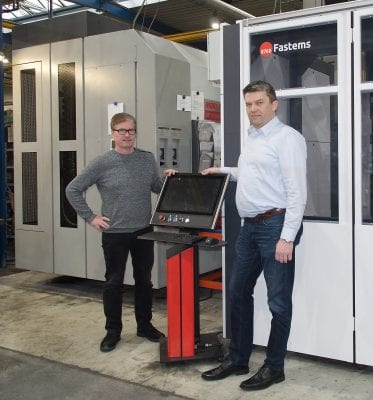
Helmut Wöhr (left), Managing Director of Buck CNC Technik, and Production Manager Frank Emmerich are satisfied with the results of RoboCell ONE and want to use the solution to leverage further potential.
Constant focus on optimization potential
Production is carried out in a flexible shift system with up to three shifts, depending on the order volume. In addition, automation has always been a key factor. For example, Buck CNC invested in a robotic cell for the first time around 18 years ago. Even before that, the majority of the CNC machines already had pallet pools. Since 2008, a flexible manufacturing system from Fastems with more than 1,000 machine and material pallets has also been in use.
High productivity is a fine thing. Nevertheless, potential for optimization is always an issue, as Production Manager Frank Emmerich knows too well: “In 2017, we decided to invest in an Index G220 turning/milling center with a counter spindle. This was done because we wanted to manufacture specific cast housings completely. We had previously produced these on a milling machine in two clamping systems. These are different products in a family of parts where we were also looking for a robot solution to load and unload the machine.”
Since the machining times are between 12 and 16 minutes, depending on the component, it was obvious from Emmerich’s point of view to integrate an existing machine. More precisely, a Mori Seiki NT4300 DCG, also with a counter spindle, for the production of similar castings into an automation solution to optimally utilize the robot.
„With RoboCell ONE, we have finally found the ideal solution for this“, says Emmerich.
Automation solution for heavy workpieces
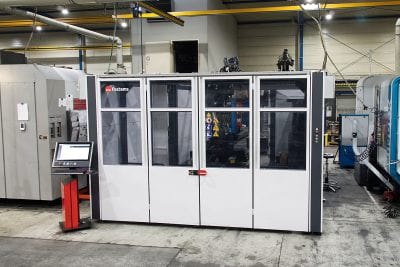
Fits into even the most confined manufacturing environments: With a footprint of 6 x 4 m, the RoboCell ONE is a space-saving automation solution.
Fastems’ RoboCell ONE is specially designed for flexible batch size production with a high degree of part variance. Moreover, it is made to automate up to two machine tools for handling mainly heavy workpieces up to 80 kg. The robot, which can move on a linear axis, thus flexibly supplies two machines with workpieces. With this, the possibility of manufacturing different products in parallel on both machines is also available.
As Emmerich explains: “We are currently using the robot cell to produce two families of parts, each with five different products on the Mori Seiki NT4300 DCG and 20 different components on the Index G220. We feed the raw parts into the system on transport trolleys with grid plates. We have two trolleys with 40 workpieces each available for each machine. An additional trolley is also reserved for the separate storage of test pieces.”
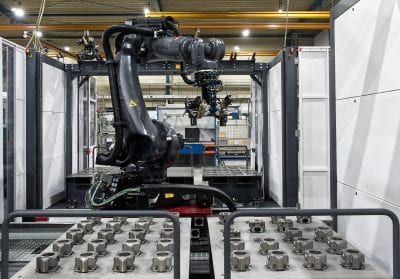
The raw parts for production are on transport trolleys with grid plates. Two trolleys per machine with a total of 40 workpieces are available for machining.
Reducing non-productive times
For handling the raw and finished parts for both machines, the Kuka robot uses one double gripper each. These are picked up and set down automatically using the integrated gripper changing station if required. “If a workpiece is changed with modified component dimensions within a family of parts, an employee manually retools the corresponding gripper via a quick adjustment.
This only takes a few minutes,” explains Emmerich and stresses: “With regard to the overall productivity of the robotic cell, the non-productive times for retooling a machine are not significant at first, since production can in principle continue with the other turning/milling center in such cases. However, we produce different families of parts with different machines and have to adapt our strategies accordingly with regard to changeover times”.
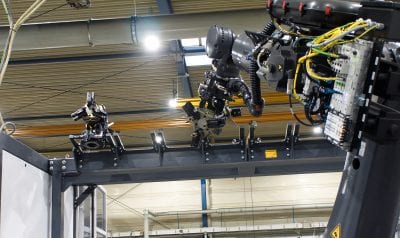
The Kuka robot automatically takes the double gripper needed for material handling from the gripper changing station. This is designed to accommodate a total of eight grippers for highly flexible workpiece handling.
The magazine of the existing machine has 102 tool places and thus a sufficient number of tools for the production of the five varying products. According to Emmerich, the clamping jaws only need to be retooled every two to three days for a product change. However, the product range manufactured on the Index is much more diversified. In turn, this means that the complete machining of all workpieces with the total of 118 tool places is not possible despite the fact that turning tools can be doubled. “When we change products, we sometimes have to reset the tools as well. However, we try to manufacture similar parts in sequence so that we can also significantly reduce non-productive time,” says the production manager.
More intelligence for production planning
Fastems Manufacturing Management Software (MMS) is a central part of RoboCell ONE. The MMS is able to automatically plan the entire production process with changing workpieces in different batch sizes according to the production orders, taking into account all the resources required for this. The software also displays the status of the current production in real time (order progress, schedule, etc.), calculates machine capacities for pending orders and displays the necessary machine changes to the operator in advance.
“At the moment, we still create the orders for production planning manually in the MMS, which also handles the master data management of the components. In the future, however, we want to transfer the orders directly from our ERP system to the MMS,” explains Frank Emmerich, with particular emphasis on the advantages of the software with regard to robot programming.
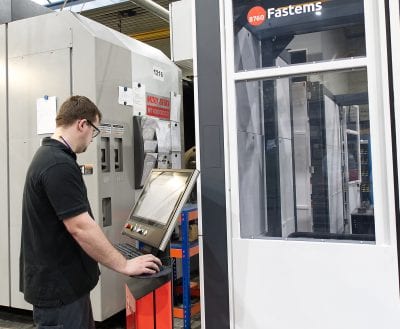
Robot configuration without programming knowledge. With parametric programming, the robot traverses can be defined quickly and easily.
No robot knowledge required
Instead of having to spend time teaching the robot a new order, it is configured by means of parametric programming via the MMS.
No robot knowledge is required for this, as the production manager confirms:
“We have received training and have learned how this works in practice using two concrete sample parts. We were then able to define the robot kinematics for the other products ourselves in a very short time. To do this, we basically only have to enter a few reference values or parameters or modify them accordingly in order to define the robot’s travel paths for loading and unloading in the cell. This is really fast and smooth, even without additional programming knowledge”.
Aiming to double unmanned times
Managing Director Helmut Wöhr believes that investmenting in RoboCell ONE more than a year ago has definitely paid off:
“It was the right decision, because now we’re able to produce a total of 25 different components from two different families of parts. This is done with two turning/milling centers in a single highly automated robot cell that’s both flexible and economical”.
In this way, we can achieve an annual output of around 20,000 parts with the Index. With the Mori Seiki, due to the comparatively longer machining times for the components, we can still achieve up to 14,000 finished parts per year and part family. Production is carried out in several shifts and with a minimum of manpower, and we are currently also able to produce around 15 different components completely unmanned over a period of three to four hours. However, our goal is to almost double this time span so that we can achieve a completely unmanned shift”.